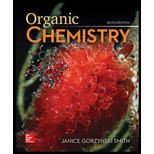
Concept explainers
(a)
Interpretation: The number of pi electrons in the given molecule is to be determined.
Concept introduction: A molecule must be cyclic, planar, completely conjugated and should follow
According to the Huckel’s rule, the number of
(b)
Interpretation: The number of pi electrons in the given molecule is to be determined.
Concept introduction: A molecule must be cyclic, planar, completely conjugated and should follow Huckel’s rule to be classified as aromatic. For an antiaromatic molecule, the molecule must be cyclic, planar, completely conjugated and have
According to the Huckel’s rule, the number of
(c)
Interpretation: The number of pi electrons in the given molecule is to be determined.
Concept introduction: A molecule must be cyclic, planar, completely conjugated and should follow Huckel’s rule to be classified as aromatic. For an antiaromatic molecule, the molecule must be cyclic, planar, completely conjugated and have
According to the Huckel’s rule the number of
(d)
Interpretation: The number of pi electrons in the given molecule is to be determined.
Concept introduction: A molecule must be cyclic, planar, completely conjugated and should follow Huckel’s rule to be classified as aromatic. For an antiaromatic molecule, the molecule must be cyclic, planar, completely conjugated and have
According to the Huckel’s rule the number of
Want to see the full answer?
Check out a sample textbook solution
Chapter 15 Solutions
ORGANIC CHEMISTRY (LOOSELEAF)
- Draw in all hydrogens and lone pairs on the charged carbons in each ion. a. b. d.arrow_forward3. How many valence electron does carbon have? А. 1 В. 2 С. 4 D. 6 4. Which of the following is INCORRECT about the number of bonds one C atom can form? A. 2 double bonds B. 1 triple bond, 3 single bonds C. 2 single bonds, 1 double bond D. 3 single bonds, 1 double bondarrow_forwardA. Choose the letter of the best answer. 1. What is a saturated hydrocarbon? A. Any compound consisting of carbon and hydrogen only. B. Any compound consisting of carbon and hydrogen and oxygen only. C. Any compound consisting of carbon and hydrogen only, in which some of the carbon atoms are joined to each other by double or triple bonds. D. Any compound consisting of carbon and hydrogen only, in which all the carbon atoms are joined to each other by single bonds. 2. What kind of hydrocarbon is C3H14? A. alkane C. alkyne B. alkene D. alcohol H. H H. 3. This molecule is an example of an... H. A. alkane C. alkyne B. alkene D. alcohol 4. Which is an example of an ether? А. CН3ОН B. CH3CH2CH2CI C. CH3CH2OCH2CH3 D. CH3CH2COOCH3 5. What is the simplest organic compound? A. methane C. ethanol B. acetone D. ethanearrow_forward
- Convert each condensed formula to a Lewis structure. a. CH3(CH2)4CH(CH3)2 b. (CH3)3CCH(OH)CH2CH3 c. (CH3)2CHCHO d. (HOCH2)2CH(CH2)3C(CH3)2CH2CH3arrow_forward1. Add missing lone pairs and C–H bonds to each of the structures below. F. A. G. В. Brarrow_forward3. Identify the functional group in each of the following molecules. a. b. NH c. d. Ph - benzen Ph Ph e. f. Brarrow_forward
- Which structure represents a different species with the other three? a b C d b. d.arrow_forwardName the functional group. Some molecules will have more than one functional group; in those cases, circle and name all functional groups present. 6. e. f.arrow_forwardMCQ 79: When a covalent bond is formed between hydrogen and a very electronegative atom, then the bond is highly A. polarized B. electronegative Eloments sous droits de C. stable D. unstablearrow_forward
- 8. Circle ALL the SP³ carbons in each of the following a. b. .OHarrow_forward3. Acetic Acid has the chemical formula CH3COOH and the H 0-H structural formula shown. Acetic H Acid is a weak acid that can lose a H proton to become the Acetate ion, CH;COO". Acetic Acid, CH3COOHarrow_forward1. Name the molecules below including the R,S designations. a. Br a b.arrow_forward
 ChemistryChemistryISBN:9781305957404Author:Steven S. Zumdahl, Susan A. Zumdahl, Donald J. DeCostePublisher:Cengage Learning
ChemistryChemistryISBN:9781305957404Author:Steven S. Zumdahl, Susan A. Zumdahl, Donald J. DeCostePublisher:Cengage Learning ChemistryChemistryISBN:9781259911156Author:Raymond Chang Dr., Jason Overby ProfessorPublisher:McGraw-Hill Education
ChemistryChemistryISBN:9781259911156Author:Raymond Chang Dr., Jason Overby ProfessorPublisher:McGraw-Hill Education Principles of Instrumental AnalysisChemistryISBN:9781305577213Author:Douglas A. Skoog, F. James Holler, Stanley R. CrouchPublisher:Cengage Learning
Principles of Instrumental AnalysisChemistryISBN:9781305577213Author:Douglas A. Skoog, F. James Holler, Stanley R. CrouchPublisher:Cengage Learning Organic ChemistryChemistryISBN:9780078021558Author:Janice Gorzynski Smith Dr.Publisher:McGraw-Hill Education
Organic ChemistryChemistryISBN:9780078021558Author:Janice Gorzynski Smith Dr.Publisher:McGraw-Hill Education Chemistry: Principles and ReactionsChemistryISBN:9781305079373Author:William L. Masterton, Cecile N. HurleyPublisher:Cengage Learning
Chemistry: Principles and ReactionsChemistryISBN:9781305079373Author:William L. Masterton, Cecile N. HurleyPublisher:Cengage Learning Elementary Principles of Chemical Processes, Bind...ChemistryISBN:9781118431221Author:Richard M. Felder, Ronald W. Rousseau, Lisa G. BullardPublisher:WILEY
Elementary Principles of Chemical Processes, Bind...ChemistryISBN:9781118431221Author:Richard M. Felder, Ronald W. Rousseau, Lisa G. BullardPublisher:WILEY





